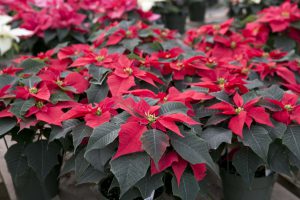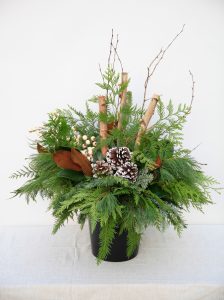by Rob Sproule
I love this plant. I loved it as a kid when it was magical. Now as an adult, understanding the science of how evolved it is, it’s still magical.
Dionaea muscipula, or “˜Venus Fly Trap’, blurs the boundaries between plant and animal. It’s a plant that refuses to be prey so it hunts instead, lying in wait and pouncing like a lion (fittingly, muscipula is Latin for “˜mousetrap.’)
Venus Fly Traps are a sensation in the houseplant world. When they come to the greenhouse children shriek in delight and their parents try to not look amazed at this plant that has evolved into a cunning predator.
By keeping a few care tips in mind, and by dispelling a few common myths, this article will help you get the most of one of nature’s most intriguing little treasures.
Basic Care
Fly Traps have evolved to get nutrients from bugs instead of soil, so their fragile roots aren’t equipped to process chemicals like nitrogen. Fertilizer will do more harm than good.
Avoid potting mix or anything else rich or with added nutrients. Carnivorous plant experts usually cite a half peat moss, half perlite blend as striking the ideal balance between good drainage and water absorption.
Tap water has a certain amount of dissolved solids in it. Although fairly harmless to most plants, to sensitive Fly Traps they can accumulate and may eventually be fatal. Watering it with distilled, filtered, or rain water is best.
It’s important not to let the medium dry out. It should always be moist (though not wet or soggy). They don’t need a lot of extra humidity, although they will thank you for the occasional misting, as long as they have adequate water.
Although many people think that Fly Traps prefer diffused light, bright sun is best. During their growing period (March to October), they need as much light as possible in order to produce big, healthy traps.
Feeding them
Amazingly, Fly Traps have evolved the ability to sense what is and isn’t prey and thus what isn’t worth the energy of closing the trap. Two trigger hairs have to be tickled to spring the deadly mechanism. It takes about 0.1 second to close, which is light-speed in the plant world.
Once closed, the trap seals to form a digestive stomach. The ideal size prey is a third of the trap size, and it takes 7-10 days to digest the unlucky fellow inside. After that, the trap opens and a drained husk falls out.
Despite their name, Fly Traps in the wild actually eat more ants and spiders than flies. You don’t need to feed it manually, as almost all houses have enough ambient bugs to keep it satisfied. If you do feed it, however, remember that it’s bugs only.
Never, ever feed your Fly Trap anything it wouldn’t catch on its own. This is the most common mistake people make. Meat products like hamburger will kill the plant with alarming speed.
Try to resist the temptation to “tease” the traps shut without feeding it. Closing the trap drains precious energy, and when that energy is spent without getting food it weakens the plant.
Special Care
Like all plants, a Fly Trap will try to bloom (and thus go to seed) as soon as it can. It blooms in the spring, and when you see a thin green stalk growing upwards, cut it off.
The flowers are tiny and white so you’re not missing much, and the plant will spend a lot of precious energy to bloom. If you cut it off the energy will be redirected to producing traps.
Contrary to popular belief, Fly Traps aren’t tropical. They are perennials native to North Carolina and aren’t as fussy about cold temperatures as you probably think.
Fly Traps need to rest for 3-5 months a year and go into dormancy. During its dormancy you’ll be forgiven if you think it’s dead. The leaves turn black, the traps fall off, and it looks all around terrible.
Dormancy may be ugly, but it’s necessary. A Fly Trap kept at room temperature all year, without dormancy, will eventually exhaust itself and die.
To simulate a North Carolina winter, put your plant on a chilly windowsill (the poorly insulated ones are great for this) that falls to between 2 degrees C and 15 degrees C in the winter.
Fly Traps can endure brief, but not extended bouts of frost. Check how cold your windowsill gets with a thermometer just to be safe (you might be surprised).















